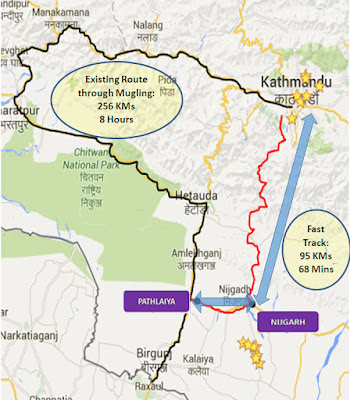Kathmandu,
May 21: Engineers have given thumbs up to the government's decision to build
the Kathmandu-Terai Fast Track road on its own.
Airing
their views on the much-talked about project, the engineers had welcomed the
government's move to mobilize the domestic resources to construct it but
insisted that it required innovative approach.
Their
support for the construction of crucial road that drastically cut short the
distance between the capital and the southern plains came as a boosting to the
government that is in the firing line from the main opposition Nepali Congress
for not awarding the project to a consortium of Indian companies that had
carried out the detailed project report.
Indian
companies led by Infrastructure Leasing and Financial Services (IL&FS) had
developed the national pride project.
"Constructing
the Fast Track on our own is a welcoming decision but new innovative
approach should be applied while
building the project because the traditional project development methods have
failed," president of the Nepal Engineers Association (NEA) Dhruba Thapa said
at an interaction on 'Engineers' view on Kathmandu-Terai Fast Track road',
organized by the NEA here Saturday.
After
more than five years of dilly-dallying about the building and financial
modality of the project, the KP Sharma Oli administration has announced to
build the expressway.
Terming
the project 'ambitious', Secretary of Ministry of Physical Infrastructure and
Transport Arjun Karki said that in order to lead the country in the path of
development, the government should be ambitious.
"Managing
financial resource for the Fast-Track Project is not challenging. We have
enough liquidity in our banking and financial system. On the other hand, there
is enough space for borrowing," he said.
Karki
said that the country had loans liability equal to about one quarter of the
Gross Domestic Product which could be raised up to 50 to 60 per cent. "It
can be built in five years by allocating Rs. 20 billion every year."
Saying
the infrastructure development should not be the issue of debate, the former
chief of Tamakoshi Hydropower Project, the largest infrastructure project in
terms of investment which is being developed by the government itself, said,
"Whatever be the financing and development strategy of the Fast-Track Road
Project, it should be completed within 5 years."
The
government has allocated Rs. 2.53 billion for the Fast Track project in the
past eight years and spent Rs. 2.76 billion.
Nepalese
Army has opened 80 kilometres long track of the multi-billion rupees project.
"Army
completed track opening a couple of years ago. It asked the government for
additional budget to make the track motorable so that the road can be used but
the government then refused to disburse additional budget hoping that it would
soon get a developer for the project," informed Uddhav Bista, head of
Nepal Army's Directorate of Development and Construction.
Army
completed the track opening in 2013. It spent Rs. 994 million in the job.
He
said that the government should make a clear plan for soil disposal management,
landslide control and security of developer and workers due to the difficult
topography and lack of public land area.
Shankar
Nath Rimal, past president of NEA, said that the government should move the
project ahead with the formulation of high-powered body.
Likewise,
Kishor Thapa, an expert member of the National Reconstruction Authority and
former secretary of the government, said that the country needed the shortest
access to the Terai along with the Simara Intarnational Airport – the planned
second international airport.
Satyendra
Shakya, chief of the Kathmandu-Terai Fast Track Road Project informed that Rs.
866.6 million was spent in land acquisition for the road.
"Land
acquisition in most of the areas, except Khokana-Bungmati 6.4 km section, has
been completed. According to rough estimates, Rs. 2.5 billion is needed to pay
compensation for the first 64 km area."
Shakya
informed that Rs. 1 billion, the budget allocated to the project for the
current fiscal year, would be spent in land acquisition.


No comments:
Post a Comment